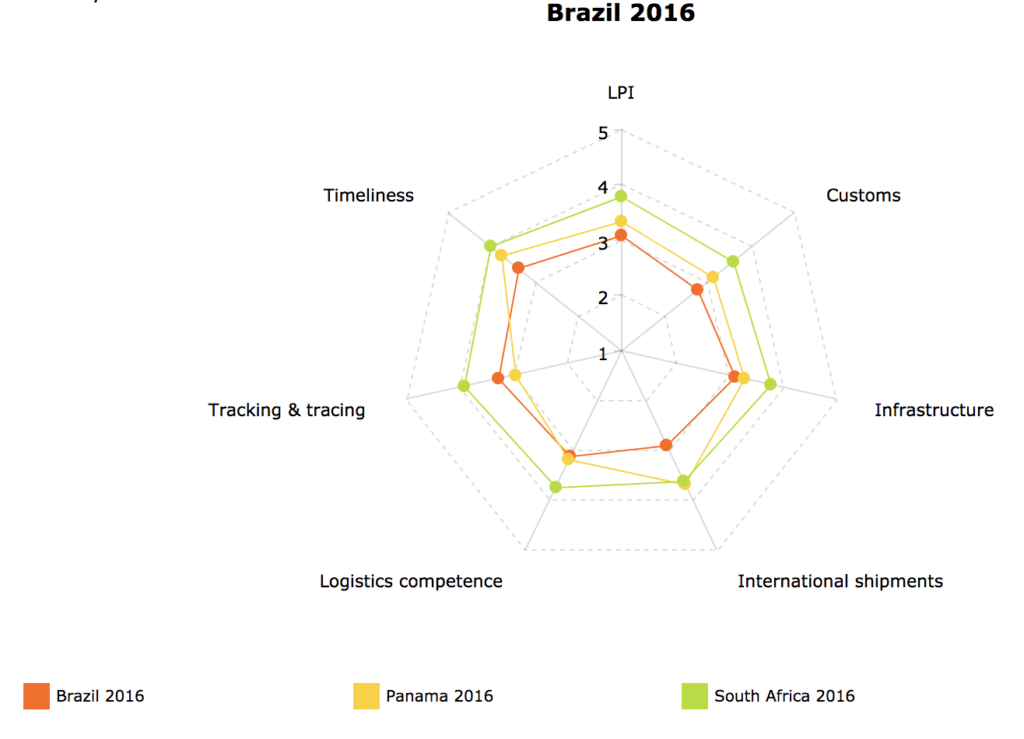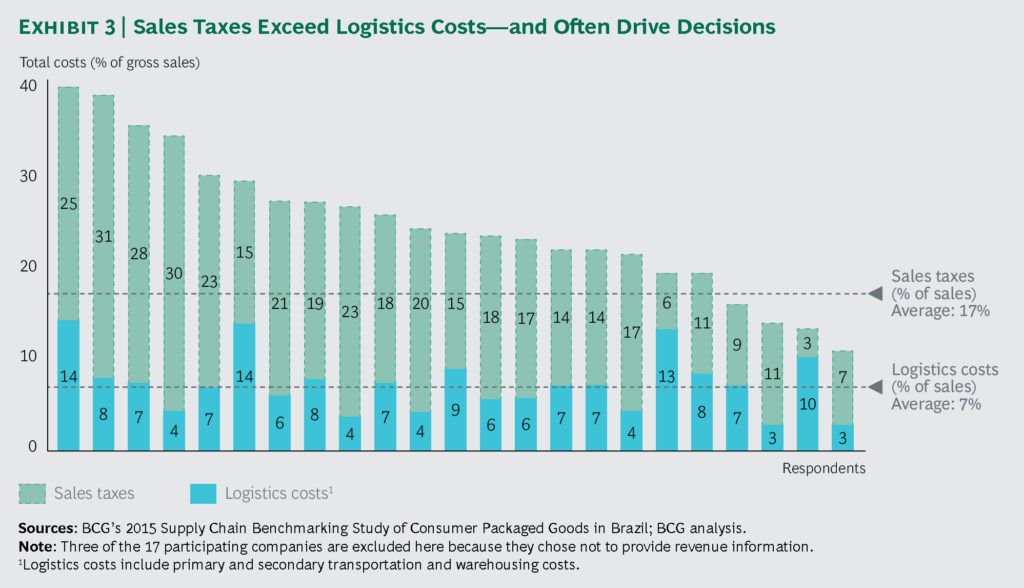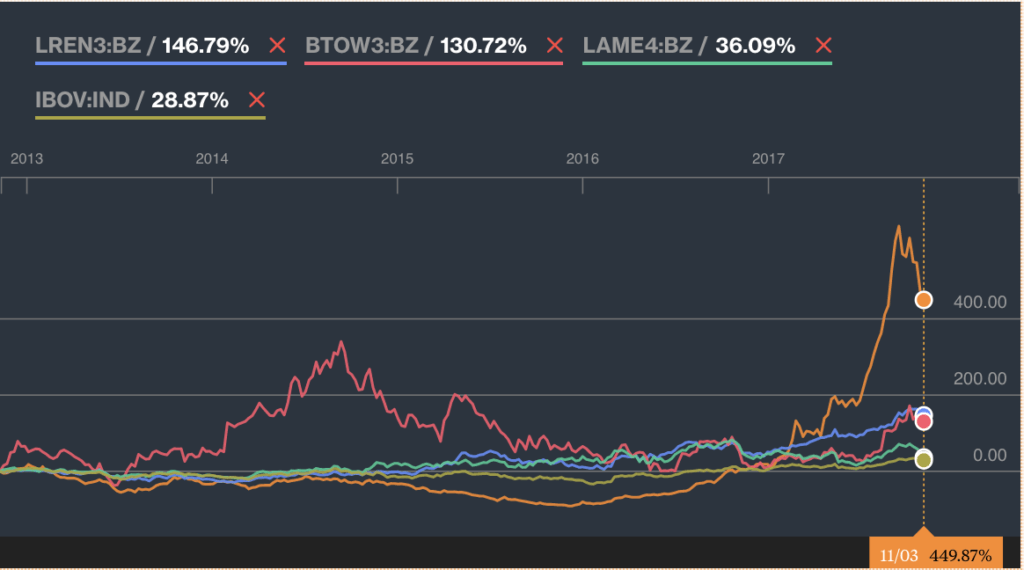Magazine Luiza 4.0: the Brazilian Amazon?

Magazine Luiza has been thriving in the complex Brazilian market for the past few years with impressive share price performance – can this brick-and-mortar retailer survive Amazon's increasing local presence?
Supply chain efficiency is a key source of competitive advantage in most developed countries: properly forecasting demand and optimizing purchases, inventories and deliveries helps boost margins in a very competitive industry. In Brazil, however, technology and supply chain management are the difference between staying in business or not, having been cited by middle-market firms as the main factors to boost productivity [1].
Unique constraints
Contrasting to Brazil’s ranking fifth in country size and population, the country is featured 55th in worldwide logistics infrastructure according to the World Bank [2], with a disappointing performance even vis-à-vis countries in the same region or income group:


Opportunity
Starting in 2014, Magazine Luiza rolled out their digital initiative to the entire company from supply chain to the creation of a marketplace to help penetration in remote regions harder to access with physical stores: in this new era, the company shifted its positioning from traditional brick-and-mortar retailer to a full digital business with physical points of sale [4]. The consequences since then have been impressive sales and profitability growth, driving the company’s stock to massively outperform competitors as well as the market index in Brazil.

Additionally, the company has been investing in the digitization of its supply chain to boost bottom-line results, with initiatives such as (i) automation of customer service through chat-bots and in-store app payments (reducing need for checkout cashiers), (ii) mobile assembly and inventory management to better plan capacity of workforce, (iii) deployment of RFID technology to improve traceability of inventory and (iv) implementation of Kaizen methodology in their fulfillment centers to improve processes and reduce costs [7].
Future Challenges
With an improving outlook for long-term investments, including mounting pressure for simplification of tax system [9], the retail market in Brazil has captured the attention of international competitors, namely Amazon announcing the long-awaited expansion of Amazon’s local operations to start selling electronics (and thus directly competing with Magazine Luiza) [10].
In order to remain competitive against Amazon’s deep pockets and strong data-driven approach, Magazine Luiza will need to take its digital initiative practice several steps further – with price pressure coming from competitors, the key differentiating factors will be (i) customer loyalty to gain scale and (ii) cost efficiency.
To the first concern, although Magazine Luiza substantially improved its e-commerce platform, it still has a long way to go in predictive analytics and leveraging on customer behavior data – Amazon has state-of-the-art technology, including CRM tactics such as subscription discounts and replenishment emails (Amazon can predict with decent confidence when you are running out of your consumable products) whereas only in 2013 did Magazine Luiza migrate towards spreading data-driven tools across the company with the adoption of Tableau [11].
Regarding cost efficiency, the jury is still out on whether Magazine Luiza will be able to improve its inventory management and distribution. The company held an average of 76.6 inventory days in 2016 [12] and unless it moves towards just-in-time integration of the supply chain, the company might face a substantial deterioration in financial performance. How can Magazine Luiza with its heavy physical presence be fast enough to react to fast competitors like Amazon?
Word Count
797
References
[1] EY (2017), “EY Growth Barometer | Brazil. Can shifting sands be a solid foundation for growth?”. Available at: http://www.ey.com/Publication/vwLUAssets/ey-growth-barometer-brazil/$FILE/ey-growth-barometer-brazil.pdf (Accessed 5 November 2017).
[2] The World Bank (2016), “International LPI Global Ranking”. Available at: https://lpi.worldbank.org/international/global (Accessed 5 November 2017).
[3] Woods et al. (2017), “Six Strategies for Beating Brazil’s Supply Chain Complexities”, BCG. Available at: https://www.bcg.com/publications/2017/consumer-products-six-strategies-beating-brazil-supply-chain-complexities.aspx (Accessed 5 November 2017)
[4] Rethans, J. (2016), “How Magazine Luiza Mastered Digital Transformation and Became one of Brazil’s Top-Performing Companies”, Huffington Post. Available at: https://www.huffingtonpost.com/entry/how-magazine-luiza-mastered-digital-transformation_us_5840686ee4b0cf3f645587de (Accessed: 5 November 2017)
[5] Bloomberg Markets (2017). Available at https://www.bloomberg.com/quote/MGLU3:BZ (Accessed: 5 November 2017).
[6] Magazine Luiza 2015 Management Report (2016). Available at http://ri.magazineluiza.com.br/show.aspx?idMateria=mZoQeKZUHLnTW8oeLFXC4Q==&linguagem=en# (Accessed: 5 November 2017).
[7] Magazine Luiza 2016 Annual Sustainability Report (2017). Available at http://ri.magazineluiza.com.br/show.aspx?idMateria=mZoQeKZUHLnTW8oeLFXC4Q==&linguagem=en# (Accessed: 5 November 2017).
[8] Moura F. and Sambo P. (2017), “Hawking TVs on Tinder Helps Fuel 2000% Rally in Brazil Stock”. Bloomberg Businessweek. Available at
https://www.bloomberg.com/news/articles/2017-08-14/hocking-tvs-on-tinder-helps-fuel-2000-rally-for-brazil-retailer (Accessed: 5 November 2017).
[9] Marcello, M. (2016), “Brazil’s president to pursue tax reform in 2017”, Reuters. Available at: https://www.reuters.com/article/us-brazil-economy-temer/brazils-president-to-pursue-tax-reform-in-2017-idUSKBN14I1ED (Accessed: 5 November 2017).
[10] Sciaudone, C. (2017), “Amazon Is Coming to the Amazon, Shaking Brazil Retailer Stocks”. Bloomberg Technology. Available at https://www.bloomberg.com/news/articles/2017-10-13/amazon-is-coming-to-the-amazon-shaking-brazil-retailer-stocks (Accessed: 5 November 2017).
[11] Tableau [2015], “Magazine Luiza gains fast access to sales data”. Available at https://www.tableau.com/solutions/customer/magazine-luiza-gains-fast-access-sales-data (Accessed: 5 November 2017).
[12] Magazine Luiza Results Spreadsheet (2017). Available at http://ri.magazineluiza.com.br/Show/Planilha-de-Resultado?=BbQU+bGLTHjGnrshXKFrLw== (Accessed: 5 November 2017).



Fc, you bring up a very interesting topic – Amazon’s competitive threat to the emerging markets. While I agree its potential entry into any country is worrisome for incumbent local retailers, I am doubtful that Amazon’s international retail expansion strategy will be as successful as its domestic dominance. Firstly, Amazon’s ecommerce business has been and continues to be largely unprofitable – the company’s performance is driven, for the most part, by the booming AWS cloud business. In fact, in 2016, AWS’s operating income was 150 percent of Amazon’s total operating income, which help offset a $541 million operating loss in the company’s international segment. [1] As such, if I were CEO Jeff Bezos, I’d be focusing much more of my attention on the cloud business than on entering markets in which I have no operating leverage or existing infrastructure and which are not likely to be profitable in the foreseeable future. Secondly, Amazon’s international presence is actually not as large as some might think. In fact, the company only fully operates its website in 13 other countries outside of the U.S. Amazon even decided to leave China given the unfavorable competitive environment, which is dominated by already established ecommerce players like Alibaba. [2]
[1] https://www.geekwire.com/2016/amazon-without-aws-online-retailer-posted-big-loss-not-booming-cloud-business/
[2] https://www.fool.com/investing/general/2015/11/17/amazoncoms-biggest-opportunity-isnt-what-you-think.aspx
FC, thanks for a very insightful look at a fascinating emerging market.
In my opinion, Magazine Luiza should take the actions that you recommended, but they also need to leverage their best competitive advantage – their retail locations. Wal-Mart’s recent successes in their fight with Amazon in the American market have provided a blueprint for how an omnichannel retailer can successfully alter its business model to incorporate digital capabilities. In addition, Magazine Luiza has another enormous advantage, their knowledge of the local market and its associated demand.
In addition to the players that you highlighted, I wonder how both Amazon and Magazine Luiza perceive local e-commerce platforms. One that jumps to my mind is B2W digital. B2W Digital is currently engaged in research collaborations with American institutions (such as MIT) and other e-commerce platforms around the world in building high-resolution models for solving urban last-mile delivery operations [1] and forecasting, learning, and price optimization [2]. In Southeast Asia, Zalora has been able to withstand Amazon’s assault by leveraging their local advantages.
[1] https://sloanreview.mit.edu/article/remapping-the-last-mile-of-the-urban-supply-chain/
[2] https://sloanreview.mit.edu/article/the-new-frontier-of-price-optimization/